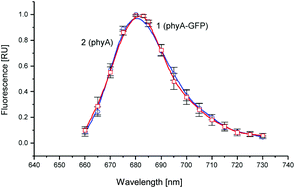phyA-GFP is spectroscopically and photochemically similar to phyA and comprises both its native types, phyA′ and phyA′′
Abstract
Low-temperature fluorescence investigations of phyA-GFP used in experiments on its nuclear-cytoplasmic partitioning were carried out. In etiolated hypocotyls of phyA-deficient Arabidopsis thaliana expressing phyA-GFP, it was found that it is similar to phyA in spectroscopic parameters with both its native types, phyA′ and phyA′′, present and their ratio shifted towards phyA′. In transgenic tobacco hypocotyls, native phyA and rice phyA-GFP were also identical to phyA in the wild type whereas phyA-GFP belonged primarily to the phyA′ type. Finally, truncated oat Δ6-12 phyA-GFP expressed in phyA-deficient Arabidopsis was represented by the phyA′ type in contrast to full-length oat phyA-GFP with an approximately equal proportion of the two phyA types. This correlates with a previous observation that Δ6-12 phyA-GFP can form only numerous tiny subnuclear speckles while its wild-type counterpart can also localize into bigger and fewer subnuclear protein complexes. Thus, phyA-GFP is spectroscopically and photochemically similar or identical to the native phyA, suggesting that the GFP tag does not affect the chromophore. phyA-GFP comprises phyA′-GFP and phyA′′-GFP, suggesting that both of them are potential participants in nuclear-cytoplasmic partitioning, which may contribute to its complexity.


 Please wait while we load your content...
Please wait while we load your content...